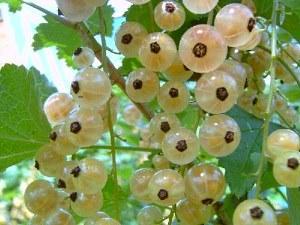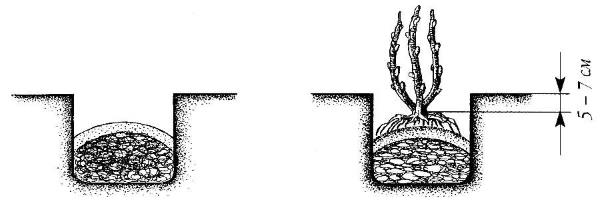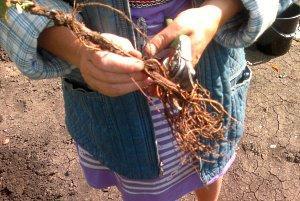White currant - growing healthy and tasty berries on your site
 White currants have a more powerful root system than black currants, therefore, with good and careful care, they can bear fruit for up to 8 years. Like many other shrubs, white currants need annual fertilization and timely pruning
... The quality of the crop directly depends on compliance with these conditions.
White currants have a more powerful root system than black currants, therefore, with good and careful care, they can bear fruit for up to 8 years. Like many other shrubs, white currants need annual fertilization and timely pruning
... The quality of the crop directly depends on compliance with these conditions.
Planting white currants - soil preparation and fertilization
In order for the planting of the white currant to be carried out correctly, and the plant to take root perfectly in a new place, you need to choose a well-lit, dry place and prepare the ground. For this:
- The required number of holes is dug, the width of which is 50-60 cm, and the depth is 35-40 cm.The upper soil layer is more fertile, it is folded at the edge of the hole, and the earth from the lower layers is mixed with mineral and organic additives: from 8 to 10 kg of peat or humus, up to 200 g of superphosphate, 25 g of potassium chloride, up to 40 g of wood ash. An important condition: the roots of the white currant should not come into contact with mineral fertilizers. They will burn the root system, and the bush will begin to ache.
- At an angle of 45 degrees. the plant is placed in a dug hole, the roots of the shrub are carefully spread, and slowly covered with soil, layer by layer, carefully compacting the ground. In order for the seedlings to harmoniously settle in their "house", they can be slightly shaken when planting - this will allow the roots to straighten out, and the earth will evenly fill the empty spaces between the roots.
- The shrub is slightly buried a few centimeters so that new shoots can appear on the buried part of the shrub, and the root system becomes denser.
- The distance between the bushes should be at least 1 meter.

White currant care in spring
For the summer period, the white currant bush should be prepared in advance. In early spring, the following activities are carried out:
- When the first buds on the branches begin to swell, the currants can be watered from time to time with hot water, the temperature of which should not exceed 70C. The plant will not suffer from this, but insect pests will have a very hard time.
- The soil under the plant should be slightly loosened and fertilized with mineral mixtures. From above, the cultivated land can be covered with a layer of rotted organic matter. It will act as a shield against insects, protect the roots on dry days and perfectly nourish the plant.
- On sunny, dry days, it is advisable to water the shrub abundantly. White currants are very fond of water. Watered regularly, it is capable of producing excellent, fragrant, juicy berries.
- It is better to pluck flowers from young bushes in the first year to allow the plant to grow stronger. Then the cultivation of white currants in the following years will not cause any trouble.
White currant pruning
To stimulate the shrub to a good harvest, every year you need to free it from old, diseased branches, which will no longer be of any use.
 Shoots that are 6-7 years old are cut from white currant bushes. They need to be carefully cut down to the very base, without leaving hemp - breeding grounds for rot and infection. Insect larvae can nest on old shoots. The thinned crown of the plant transmits sunlight well and bears fruit well.
Shoots that are 6-7 years old are cut from white currant bushes. They need to be carefully cut down to the very base, without leaving hemp - breeding grounds for rot and infection. Insect larvae can nest on old shoots. The thinned crown of the plant transmits sunlight well and bears fruit well.
Pruning can be done in the spring before the first buds appear, in the summer after the crop has been harvested, or in late fall when the plant is dormant.Most often, gardeners process shrubs immediately after the berries have been harvested. Leaves and unnecessary shoots are removed from the plant. Caring for white currants also includes additional soil feeding. It is advisable to water the soil with solutions to which mineral and organic fertilizers have been added.
White currant propagation method - cuttings
 Having planted several white currant bushes, you can use cuttings in order to multiply their number. In a mature and established plant, cuttings with 5-7 buds are carefully cut from the middle part.
Having planted several white currant bushes, you can use cuttings in order to multiply their number. In a mature and established plant, cuttings with 5-7 buds are carefully cut from the middle part.
If this is done in February, then the cuttings placed in the water will sprout. In spring, cuttings are placed in moist, well-loosened soil, pressing them at an angle of 45C.
Seedlings are covered with jars or foil, protecting them from the weather. If grafting occurs in the autumn, then the soil is additionally covered with spruce legs and protected with a layer of rotted organic matter.
Cuttings are planted in a well-lit area. The sun's rays work wonders with berries: they become sweet and tart in taste. In shaded areas of the land, the berries of the plant become sour.
Amateur gardeners love to tinker with white currants, as they produce good yields of healthy and delicious berries that make excellent berry jelly, jams, tinctures and other food products. The berry is rich in useful trace elements and vitamins, which the human body desperately needs in winter. Fruit drinks, compotes, jam with tea perfectly quench thirst, promote recovery during colds, are very tasty and pleasant. Both children and adults love white currants.
Currant is a very healthy and tasty berry. Once upon a time in childhood, my grandmother grew a white currant. I loved her very much because of her unusual color. Now I grow currants in my garden, but only black and red, and somehow I forgot about white. I will definitely plant it next year. And, I wonder what vitamins and nutrients are in white currant? The same as in red?
PS: I really liked the place in the article, where it is recommended to water currant bushes with hot water in spring in order to fight insects. Didn't know about this method. Thanks to the author.